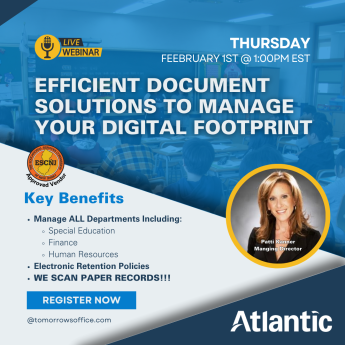Print Smarter, Greener: Sustainable Practices to Reduce Waste
Even as businesses transition to digital processes, printing continues to play a significant role in our daily office routines. However, with the increasing awareness of environmental impact, organizations worldwide are recognizing the importance of adopting sustainable practices to cut down on paper waste and embrace eco-friendly alternatives. This blog explores current obstacles to success, practical tips to print smarter and greener, and ways to build a culture of sustainability in your business.
Recognizing the Challenges Ahead
The Environmental Protection Agency (EPA) estimates that paper and paperboard alone account for about 25% of landfill waste and 33% of municipal waste.
Overprinting, A Common Problem
Did you know it’s estimated that producing a single ton of office paper can result in approximately 5.6 metric tons of carbon dioxide equivalent emissions? If you look around the office, if yours is like most, you’ll see unclaimed paper at the printer and in garbage bins and scattered on desks. Overprinting not only uses up valuable resources such as paper and toner but also contributes significantly to environmental degradation. Despite the advancements in technology, overprinting remains a persistent issue, impacting both the environment and a company’s financial results.
Neglecting Recycling
Statistics reveal that the recycling rate for print cartridges in the United States falls below 30%, highlighting a significant gap in sustainable practices. By disregarding the recycling of toner cartridges and paper products, businesses miss a crucial opportunity to reduce their environmental footprint. Embracing recycling initiatives can lead to substantial reductions in waste generation and resource consumption, benefiting both the environment and the bottom line.
Energy Inefficiency of Underused Devices
An underused printer or copier can negatively impact the environment in several ways. While idle, these machines continue to consume energy, adding to unnecessary electricity use. They frequently contribute to the waste of paper and toner, driven by factors like test prints, misprints, and maintenance cycles that persist regardless of actual printing demands. Also, underused printers can necessitate more frequent cartridge replacements as cartridges may dry out or lose efficacy from lack of regular use. Addressing this environmental concern requires a comprehensive approach, encompassing optimizing device usage, incorporating energy-efficient technologies, and deploying intelligent print management solutions.

Navigating the Path to Sustainability
By adopting eco-conscious strategies, companies can not only minimize waste but also contribute to a greener future. Here are some key steps businesses can take to promote sustainability in their office printing environment:
- Use Recycled Paper: Consider paper made from recycled materials. This reduces the demand for virgin wood pulp, conserves natural resources, and reduces energy consumption and carbon emissions associated with paper production.
- Duplex Printing: Enable duplex (double-sided) printing whenever possible to reduce paper consumption. This simple practice can halve paper usage without compromising print quality.
- Print Preview and Print-On-Demand: Encourage employees to use print preview options before printing to avoid unnecessary prints and minimize errors. Additionally, consider implementing print-on-demand practices to produce only the required number of copies, reducing excess printing and waste.
- Digital Alternatives: Embrace digital alternatives to printing, such as electronic documents, emails, and digital signatures. Use collaborative document editing tools and project management software to facilitate digital workflows and reduce reliance on physical prints.
- Energy-Efficient Printing Devices: Invest in energy-efficient printing devices with energy-saving features such as automatic sleep mode and power-off timers. Energy-efficient printers consume less electricity, reducing both operational costs and environmental impact.
- Printer Fleet Optimization: Assess the printing needs of your organization and optimize the printer fleet accordingly. Consolidate devices to eliminate redundant printers and utilize multifunction printers (MFPs) that combine printing, scanning, copying, and faxing functionalities in a single device.
- Recycling Programs: Implement ink and toner cartridge recycling programs within the organization. Partner with manufacturers or third-party recycling companies to collect and recycle used cartridges, preventing them from ending up in landfills.
- Employee Training and Awareness: Educate employees about the environmental impact of printing and promote sustainable printing practices through training sessions, awareness campaigns, and internal communications. Encourage employees to print responsibly, minimize waste, and utilize digital alternatives whenever possible.
- Managed Print Services (MPS): Consider partnering with a Managed Print Services provider to optimize printing resources and reduce waste. MPS providers can assess printing needs, streamline workflows, and consolidate devices to minimize unnecessary printing and maximize efficiency.
According to a study by the United Nations, business waste accounts for approximately 20% of the world’s waste, with offices being a significant contributor.
Building a Culture of Sustainability
Creating a sustainable framework within your organization involves more than just implementing initiatives; it’s about nurturing a culture that embraces sustainability at its core. By harmonizing your strategic direction with a shared vision that addresses challenges while instilling a sustainable philosophy, you pave the path toward enduring success and meaningful change. Here are some ways you can drive positive outcomes for your business and beyond:
- Leadership Commitment: Sustainability initiatives must be championed from the top down. Leadership should demonstrate a strong commitment to sustainability by setting clear goals, allocating resources, and integrating sustainability into the organization’s mission and values.
- Incorporate Sustainability into Company Policies: Integrate sustainability considerations into company policies, procedures, and decision-making processes. This can include procurement policies that prioritize environmentally friendly products, energy-saving protocols, waste reduction strategies, and sustainable supply chain management practices.
- Empowerment and Engagement: Encourage employee participation and engagement in sustainability initiatives. Provide opportunities for employees to contribute ideas, suggestions, and feedback on sustainability-related matters. Empower employees to take ownership of sustainability projects and initiatives within their respective roles and departments.
- Recognition and Rewards: Recognize and reward employees who demonstrate exemplary commitment to sustainability. This can include incentives, awards, and public recognition for achievements in sustainability leadership, innovation, and impact.
- Collaboration and Partnerships: Foster collaboration with external stakeholders, such as suppliers, customers, community organizations, and industry peers, to advance sustainability goals. Seek partnerships that align with the organization’s values and objectives and leverage collective expertise and resources to drive positive change.
- Transparency and Reporting: Maintain transparency in sustainability efforts by regularly communicating progress, challenges, and performance metrics to internal and external stakeholders. Publish sustainability reports or disclosures that outline goals, targets, achievements, and areas for improvement, demonstrating accountability and credibility.
- Continuous Improvement: Embrace a culture of continuous improvement by regularly evaluating and refining sustainability strategies, initiatives, and performance. Encourage innovation and experimentation to identify new opportunities for sustainability innovation and impact.
- Lead by Example: Demonstrate leadership in sustainability by implementing best practices, adopting green technologies, and reducing the organization’s environmental footprint. By leading by example, businesses can inspire others to follow suit and contribute to a collective culture of sustainability.
- Community Engagement: Engage with the local community through outreach programs, volunteer initiatives, and partnerships that support environmental conservation, social responsibility, and sustainable development. By actively contributing to the well-being of the community, businesses can strengthen their reputation and impact positively.
By incorporating these strategies, businesses can foster a culture of sustainability that permeates throughout the organization, driving positive change and creating lasting value for both the company and the planet.
Towards a Greener Tomorrow
The necessity to embrace sustainable practices has never been greater. From addressing the challenges of overprinting, neglecting recycling, and energy inefficiencies to championing innovative solutions and advocating for systemic change, companies have a vital role to play in shaping a greener future.
About Atlantic, Tomorrow’s Office
Atlantic is an award-winning office technology and IT solutions company providing Imaging Products, IT Support, Document Management, Cybersecurity and Managed Services to small and large companies in the New York City metropolitan area, and the Greater Philadelphia and Delaware Valley.
For the latest industry trends and technology insights visit ATO’s main Blog page.


























